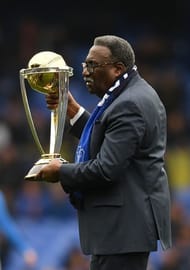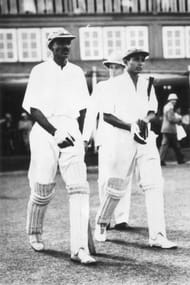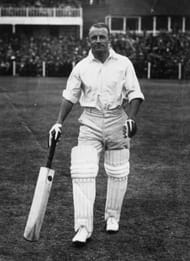
Centuries have often been the most prevalent benchmark the performance of a batsman in any form of cricket. The advent of limited overs cricket since 1971 may have shifted a part of the concentration of cricket analysts from centuries to quick fire half centuries, but even till today, the number of centuries scored by a particular batsman in his entire career, becomes a major parameter, while comparing all-time greats and legends of the game.
While, we cricket fans are left spellbound by the number of centuries scored by legends like Sachin Tendulkar, Virat Kohli, Jacques Kallis, Kumar Sangakkara, rarely do we pay attention to the quality of a century i.e. the match situation, the challenging pitch conditions that the batsman had to battle through, and bowling attack he had to counter, in order to get to the century.
In very sparse occurrences, specific centuries have remained in record books for their sheer brilliance like Gundappa Vishwanath's majestic 139 in Calcutta Test 1974 or Sir Viv Richard's brutal 189 against England in 1984. Hence, barring the exceptions, our general trend is to assign the same weight to all centuries, notwithstanding the impact that a specific century might have had on world cricket.
In this account, 3 centuries have been shortlisted from all the matches played between 1901 and 1999, as the knocks that changed and made the game, the one we all are familiar with. These centuries had not only been exceptional performances from the batsmen on that given day, but they have also had a significant effect on the history of cricket. In fact, all these centuries have had a major role to play in the present standing of cricket in the sports world.
#3. Clive Lloyd (102) West Indies vs Australia 1975 World Cup Final, Lord's

Background of the Match: Australia and England had played the first limited overs international match on 5th January 1971, at the MCG. However, the ever so conservative cricketing world was averse to any change from the traditional 5-day format of the game. As a consequence of that, in between January 1971 and June 1975, there were only 18 ODI matches organized by ICC.
It was becoming increasingly prominent, that there had to be a watershed move from the cricketing council, to prevent ODI cricket from dying a premature death. Thus the World Cup of 1975, was in many ways, a desperate effort to globally recognize limited overs cricket and more importantly, an attempt to broaden the cricketing audience, outside the posh intellectual circle.
Australia and West Indies made their way to the grand final of the first ever cricket world cup. It had been quite a docile tournament so far, with the odd good competitive matches, smeared with a lot of one-sided dead rubbers in between. The tournament had been a good dose of high-quality cricket in patches, but nothing path-breaking, as the ICC was expecting it to be. Under these circumstances, the final of the Prudential World Cup began.
Course of the Match: Ian Chappell won the toss and put the West Indies into bat, on a nice June afternoon at a full-house Lords. Lillee and Thompson breathed fire like they so often did in their prime and removed the illustrious top 3 of Frederick, Kalicharran, and Greenidge, in no time, with a mere 50 runs on the board. Out came the 'big cat' of West Indian cricket, Lloyd at No. 5 and joined hands with Rohan Kanhai. What followed in the next 100 minutes was carnage and demolition at its supreme best.
Clive Lloyd clipped and pulled and hooked, as the pace quartet of Dennis Lillee, Jeff Thompson, Max Walker, and Gary Gilmour looked on, in desperation. Lloyd scored a century in 100 minutes, off just 85 deliveries, mauling the much famed Australian attack, at the Mecca of cricket. Such was the dominance of Clive, in the innings, that the legendary Rohan Kanhai was reduced to look a pale shadow at the non-strikers' end.
Finally, when the onslaught ended, the Windies had cruised to an above par total of 291, leaving the demoralized Aussie batting line-up to chase a steep target of 292, for winning the first ever cricket world cup. Australia fought hard, but fell short of the target by a mere 17 runs
Historical Importance: Contemporary staunch critics of ODI cricket claimed that the limited overs version of the game was just a circus. Had it not been for this century by Lloyd, ODI cricket would have died in the annals of history, with the inaugurating cricket World Cup. This 85-ball-inning made the cricket world sit up and take notice. Cricket started spreading beyond the restricted circle of steadfast purists and the cricketing euphoria started gripping the world
#2. Lala Amarnath (118) India vs England 1933 1st Test, Mumbai

Background of the Match: India had played their first ever Test match under the captaincy of Col. CK Nayudu in 1932 at Lord's vs England. It had been a historic occasion for the Indian Team, as they became the first Asian team ever to be granted full member status by ICC. It had been a major step in the globalization of the game. However, along expected lines, India’s performance at the Lord’s Test against the experienced England side under Douglas Jardine had been below average. The Indian batting line-up collapsed to hand England a victory by 158 runs.
The performance of India started raising doubts in the global cricketing fraternity about India’s ability to thrive in competitive cricket in the future. Amidst all these speculations, England came to India next year, 1933, for the return Test series and the 1st Test of the series was scheduled to be played at Mumbai (then Bombay) gymkhana ground.
Course of the Match: India, batting first, scored 219 in their first innings, with familiar problems troubling the Indian batsmen yet again. All of the top 6 batsmen got to starts but were unable to convert them. The top scorer of the innings was a 22-year-old debutant form Punjab, Lala Amarnath, with a score of 38. England came out all guns blazing in reply and posted a massive total of 438, with Bryan Valentine, leading the way with a gracious 136.
India, came into bat, in the second innings, knowing that, the test was already lost as the lead itself amounted to 218 runs, after the first innings of both the teams. In the 2nd innings, India’s woes, however, continued, as both the openers were dismissed with only 21 runs on the board.
That brought together 2 men on the crease, who redefined Indian cricket and silenced the critics, who doubted India’s ability to play Test cricket at international level. Lala Amarnath, the top scorer from the first innings, compiled the first ever century by an Indian Test cricketer at international level (118), with the captain Col. C.K.Nayudu playing second fiddle to him (67). They came together for a partnership of 186 runs, that helped India avoid the embarrassment of an innings defeat.
However, after this partnership, India suffered a massive collapse and succumbed to 258 all out. England knocked off the meager target of 40 runs with the fall of just 1 wicket.
Historical Importance: The century from Lala Amarnath, reinstated the belief of the cricket world, that Indian batsmen were capable enough to handle experienced England bowlers and score against them. India and the entire of Asia subsequently began believing in themselves after this century, that the Indians can afford to beat England at their own game. Oozing from the confidence of this century, India managed to draw the next Test of the series at Eden Gardens, Kolkata. Going by where cricket in India has come, as of today, that century from Lala Amarnath at Mumbai, can be termed as the harbinger of a new age in Indian cricket history.
#1. Don Bradman (270) Ashes 1937 3rd Test, MCG

Perhaps it is only rhetorical, that such a significant historical list of cricket centuries has the 1st global batting superstar at the top - Sir Don Bradman and his century at the Ashes of 1937. But, in order to understand the impact of this innings of Donald Bradman on cricket history, a little background information is essential.
Background of the Match: Australia had come into the 3rd Test of the Ashes of 1937, after being absolutely annihilated in the first two Test matches, by England. The margins of victory had been 322 runs and an innings and 22 runs, at Brisbane and Sydney, respectively. The English victory of the Ashes was looking inevitable and Bradman’s captaincy had been heavily questioned by cricket experts and analysts. This was the backdrop of the 3rd Test match at MCG.
Course of the match: Australia finished the 1st day of the match at 181 for 6. However, overnight rains affected the pitch bigtime, and in order to put the opposition in, on a spiteful pitch, Bradman strategically declared the innings on 200 for 9, next day morning. England, as expected, succumbed to 76 for 7 on the damp pitch and then the English Captain Allen purposefully declared the innings as well, with the hope of backfiring Bradman’s strategy on Australia.
However, his Australian counterpart, had other plans, as he sent out two tail-enders, O'Reilly and Fleetwood-Smith to open the innings, in order to protect his top order batsmen. When the first wicket fell, came out another tail ender, in the form of Frank Ward. In unforeseen circumstances, Bradman almost reversed the entire Aussie batting order. As a consequence, the best batsmen came out to bat, only when the pitch had improved significantly.
Bradman, himself came out to bat when the Australian scorecard read 97 for 5, and he knew extremely well that, with the pitch conditions improving fast, it would not be tough for England to chase anything under 300 in the 4th innings. Australia’s only chance of keeping the series alive rested upon the Don.
No wonder, the legend lived up to the expectations. He piled on runs, as the wicket improved slowly, playing with patience and perseverance, to compile a historical inning of 270 runs, thus batting England out of the contest.
Historical Importance: This was exactly where the Ashes 1937 turned and Australia won the 3rd Test match and went on to win the next two Test matches, to seal the series 3-2. The double century of Bradman was much more significant than turning the Ashes towards Australia, because the Australian selectors, who were contemplating on scraping Bradman of leadership, on Australia’s probable defeat in the Ashes, had to dump the idea for good, after such a turnaround.
Maybe, if not for this century, Bradman, one of the greatest Test captains Australia have ever had, could have well been known to be a legend of the game, who succumbed to the pressure of leadership on the field.
Follow IPL Auction 2025 Live Updates, News & Biddings at Sportskeeda. Get the fastest updates on Mega-Auction and cricket news
